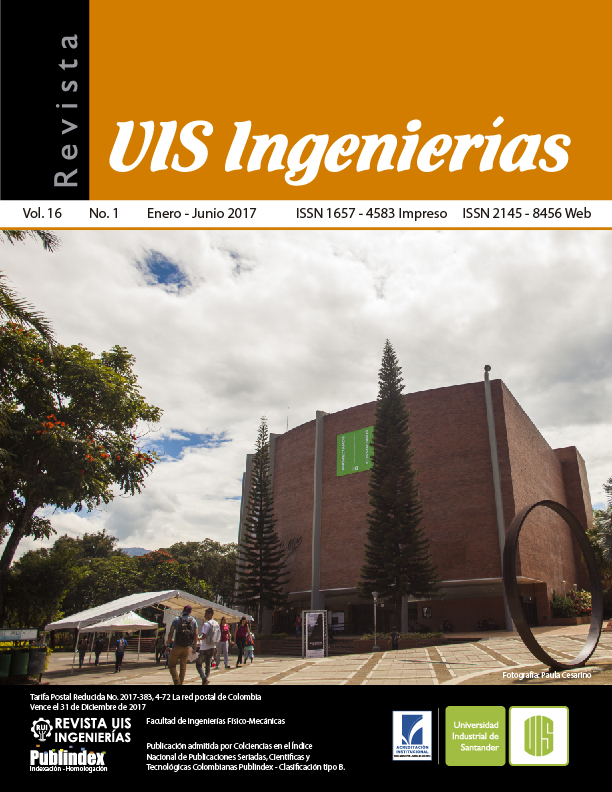Published 2016-12-30
Keywords
- Comodidad,
- diferencial semántico,
- percepción visual
How to Cite
Copyright (c) 2016 Revista UIS Ingenierías

This work is licensed under a Creative Commons Attribution-NoDerivatives 4.0 International License.
Abstract
When ergonomic criteria are separately applied to the design of chairs, the feeling of comfort is not guaranteed. In this case, the aesthetic and perceptive features of the chair provide the sensations of comfort, and several studies have determined that comfort and discomfort present some characteristics that make them different from each other. Moreover, early judgements by the user remain invariable when there is no interaction between the person and the object. Therefore, it can be assumed that if a device is considered comfortable after an initial experience of use, it may well not be thought as such after extended use. Based on this, the present research study aimed at establishing the differences in the perceptions of comfort of two chairs before and after extended sitting posture. Six subjects participated in this study, all they were women from 20 to 45 years of age, who usually perform office work in extended sitting posture, with a body mass index (BMI) ranging between 20 and 30 Kg/m2. In the experiment, four office tasks were assigned (reading, transcribing a text, handwriting and searching on the internet) during sixty minutes. The experiment was divided into two sessions, in order to use the two chairs subject of the study. Each participant was assessed at the same hour but in two different days. By means of the semantic differential, evaluations of visual perception were carried out by the participants before and after using the chair. The results reveal differences in the perception evaluation of both chairs before and after their use. In the case of the chair a, the assessment of the adjectives never decreased. This study shows that the pleasure provided by a product is not static and it does evolve on the basis of product time of use and manipulation. Even though there were no statistical differences in the adjective pairs studied when only one chair is examined, it was demonstrated that its perception may improve or worsen on the basis of time. Similarly, this perceptual behavior is not indifferent to the object, finding significant differences before and after use when comparing the chairs. Finally, this analysis tool provides better evidence on product functionality by indicating whether there are failures in the proposed design.
Downloads
References
- D. B. Chaffin, G. Andersson, and B. J. Martin, Occupational Biomechanics. New York: J. Wiley & Sons, 2006.
- M. R. Jouvencel, Ergonomía basica. Aplicada a la medicina del trabajo. Madrid, 1994.
- S. M. McGill, N. S. Kavcic, and E. Harvey, “Sitting on a chair or an exercise ball: various perspectives to guide decision making,” Clin. Biomech., vol. 21, no. 4, pp. 353–360, 2006.
- M. G. Mohamed Thariq, H. P. Munasinghe, and J. D. Abeysekara, “Designing chairs with mounted desktop for university students: Ergonomics and comfort,” Int. J. Ind. Ergon., vol. 40, no. 1, pp. 8–18, 2010.
- D. Harrison, et al, “Sitting biomechanics Part I: Review of the Literature,” J. Manipulative Physiol. Ther., vol. 22, pp. 594–609, 1999.
- C. Lelong, et al, “Biomécanique rachidienne et station assise,” Rev. Rhum., vol. 55, no. 5, pp. 375–380, 1988.
- A. R. Tilley and H. D. Associates, The measure of man and woman. New York, USA: John Willey & Sons, INC, 2002.
- S. M. Carcone and P. J. Keir, “Effects of backrest design on biomechanics and comfort during seated work,” Appl. Ergon., vol. 38, no. 6, pp. 755–764, 2007.
- C. García-Molina, et al, “Guía de Recomendaciones para el Diseño de mobiliario ergonómico,” Inst. Biomecánico Val. Val., 1992.
- B. J. Andersson, et al, “The sitting posture: an electromyographic and discometric study.,” Orthop. Clin. North Am., vol. 6, no. 1, pp. 105–120, 1975.
- M. P. De Looze, L. F. M. Kuijt-Evers, and J. Van Dieen, “Sitting comfort and discomfort and the relationships with objective measures,” Ergonomics, vol. 46, no. 10, pp. 985–997, 2003.
- M. Helander and L. Zhang, “Field studies of comfort and discomfort in sitting,” Ergonomics, vol. 40, pp. 895–915.
- L. Zhang, M. G. Helander, and C. G. Drury, “Identifying factors of comfort and discomfort in sitting,” Hum. Factors J. Hum. Factors Ergon. Soc., vol. 38, no. 3, pp. 377–389, 1996.
- D. Norman, El diseño emocional, Por qué nos gustan (o no) los objetos cotidianos.1a ed. Barcelona, España: Paidós, 2005.
- P. W. Jordan, Designing pleasurable products: An introduction to the new human factors. 1a ed. New York, USA: Taylor and Francis, 2002.
- C. E. Osgood, G. J. Suci, and P. H. Tannenbaum, “The measurement of meaning (Vol. 1),” Urbana Univ. Illinois Press, 1957.
- S. Na, et al , “Evaluation of driver’s discomfort and postural change using dynamic body pressure distribution,” Int. J. Ind. Ergon., vol. 35, no. 12, pp. 1085–1096, 2005.
- M. Vergara and A. Page, “Relationship between comfort and back posture and mobility in sitting-posture,” Appl. Ergon., vol. 33, no. 1, pp. 1–8, 2002.
- P. Vink, et al, “Three experiments to support the design of lightweight comfortable vehicle seats,” Work, vol. 41, no. Supplement 1, pp. 1466–1470, 2012.
